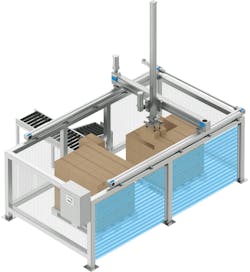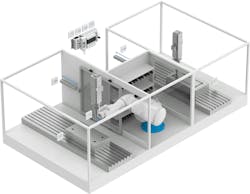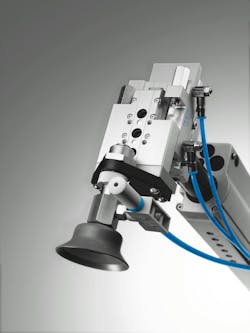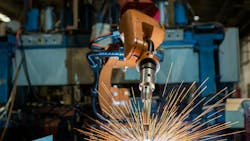Pneumatics Provide a Tried-and-True Technology for Robotics
There are several factors to consider when implementing a robotics solution, including the type of motion control technology to utilize. Pneumatics are often used to move a robot arm or for end-of-arm tooling on a robot.
Using pneumatics for robotics provides many benefits, including lower maintenance and installation costs. It can provide the speed and force required of many applications as well, with pick and place being a common one.
As with any technology, it is important to have a thorough understanding of the application requirements to determine whether pneumatics is the right option for a robot versus hydraulics or electronics.
Power & Motion spoke with Cory Knight, Automation Technical Engineer – Food and Packaging, and Brian Rockwell, North American Key Account Manager, at Festo about the pros and cons of using pneumatics for robotics applications as well as key factors to consider when implementing the technology.
*Editor’s Note: Questions and responses have been edited for clarity.
Power & Motion (P&M): What robotics applications typically use pneumatics?
Brian Rockwell (BR): First, I think it's important for us just to be on the same page about robots. The way I would define a robot is something that replicates human movements and functions automatically.
With that in mind, there are many different applications that are suitable to use pneumatics; probably the most popular would be a pick and place system where you're picking up an object and you're moving it and placing it in a different location. There are also material handling systems like conveyor systems, different tables that push and pull loads from one point to another. There are active gripping mechanisms that use pneumatics. For part manipulation and movement, there are a lot of different use types.
We develop technologies like grippers, and different end-of-arm tools that go on the end of a robot that are very suitable for picking up and manipulating loads. Those are the common material handling technologies that are used with pneumatics. But you also have secondary use cases, like tightening systems, torquing systems, pressing components together, joining components together through welding as an example. And then there's painting technologies that use pneumatics. Those are a handful of different use case opportunities that I see.
Cory Knight (CK): If we drill a little bit further [into the] food and packaging industry segment, a version of pick and place is case packing. That would be a very widely used area for pneumatics for picking and placing objects into a case. And then also palletizing and depalletizing – picking a case and building a pallet with it. And then primary packaging for picking and placing an object into its primary pack. So primary packaging, secondary packaging, and tertiary packaging, all within the food and packaging industry segment, use pneumatics [for] robotics.
READ MORE: Rapid Growth Ahead for Mobile Robot Components Market
P&M: What are the pros and cons of using pneumatics in robotic applications?
CK: There's definitely pros and cons to pneumatics in robotics. Some of the pros first are high speed. When you talk about pneumatics versus an electric solution, such as an electric actuator, typically you're going to achieve a higher speed on the linear motion or rotary motion with a pneumatic actuator when you compare that to an electric solution. That’s a huge benefit. They’re simple and reliable, that would be another pro for pneumatics; [pneumatics is] very simple to work on, they’re kind of a tried-and-true technology [which provide] millions and millions of cycles without any type of maintenance.
Very cost effective would be another pro to pneumatics. You compare just a pneumatic cylinder or pneumatic rotary compared to an electric solution, it's really difficult to beat a pneumatic solution. It's just lower cost overall. And then the power-to-weight ratio – with a pneumatic cylinder or pneumatic actuator, you have this ability to exert a really high force with a very small and lightweight package, that's hard to beat when you look at any other technology. I think the last pro would be hazardous locations, whenever you're dealing with explosive or flammable gases or liquids, if you're just using compressed air, you don't have any high voltage so that's a really nice pro for pneumatics.
Some of the cons, though, [include] limited precision, meaning if you're trying to do a really fine move or to do some type of controlled process, pneumatics is lacking in that area. Limited force control would be another one; you have that force available to you but if you wanted to have an exact, light-touch force on a component that's when you're starting to get into the servo pneumatics or high-end control for pneumatics [because] pneumatics typically just want to run at a constant air pressure and do the same thing over and over again.
Noise and vibration could be a con for pneumatics, dealing with all of the exhaust air, higher forces and the banging of a cylinder. A lot of times if you don't use the proper energy damping with pneumatics, you'll have a bang and a vibration as a result of a pneumatic actuation. So, those can be limiting factors. And then sometimes energy efficiency could be [a con]; pneumatics can oftentimes be viewed as less energy efficient than electrical systems. When an electrical system is sitting there, it's not using any power unless it's doing work. Whereas a pneumatic solution, sometimes there's leaks, sometimes there's more air consumption as a result of some external factor. Those would be my pros and cons to pneumatics in robotics.
BR: There are occasions where you’re in an area of a facility that has limited power availability. In that case, you may not be able to access [an electronic power supply], so pneumatics may be an easier option to consider. If it is a complex move that requires multiple positions, then pneumatics might not be a good solution. [Pneumatics] is going to be for more basic movements. Reinforcing what Cory said, simple [applications] are pneumatics and complex would be other technologies.
P&M: What are some key factors to consider when determining whether pneumatics or another technology should be used in a robotics application?
BR: It's evaluating the application, really doing a lot of homework on what's required. What we would typically [do is look at] how fast a process is, how accurate it needs to be, and is there a force and torque requirement for whatever operation you're trying to do. As you get into environmental considerations, these are all helping you determine whether it's going to be hydraulic, electrical, or pneumatic.
Then the cost is always a big one. And one that slips through the cracks a lot of times is the knowledge of your maintenance staff. A lot of customers may have a maintenance staff that has never worked with robotics, as an example, so they feel more comfortable with pneumatics. Or they may be very skilled with robots and not have a lot of experience with pneumatics. It really just depends on the knowledge base that you're working with. Those are some of the main considerations that we walk our customers through. [Also], whether or not they have an energy efficiency mandate at the facility, if there's any noise and vibration requirements for the environment because that will also dictate that maybe pneumatics isn't going to be a good choice because it does cause a lot of noise and vibration. I would say on a high level [those are some] key considerations.
CK: One other thing, [which] Brian touched on already, is the familiarity of the customer with the technology. And then weight, that’s a huge point that always comes into play is how much does the thing weigh if it’s going to be used as an end-of-arm tool. Every ounce that the end-of-arm tool itself weighs takes away from the payload capability of the robot and the operator to do what they want to do in carrying the load or conducting the process. Oftentimes weight is a huge conversation when deciding which technology to go with when you’re talking about doing simple linear motion with an electric actuator versus a pneumatic actuator.
When you compare one to one, with electric you’re going to have some type of motor involved, an axial kit, a motor coupling, maybe there’s belts and pulleys, is it a pulley drive or a ball screw, there’s linear bearings; there’s all these types of mechanical components inside of an electric actuator just to get you 1 in. of stroke of linear motion. Whereas within a pneumatic cylinder you only have a tube, a piston, and a rod. So, it’s obviously much lighter weight and that’s probably one of the top considerations when [deciding to use] pneumatics or another technology.
READ MORE: “Making Automation Easy Starts With the Design Process”
P&M: When someone does choose to use pneumatics in a robotics application, what steps or best practices should be followed to ensure proper installation and performance?
CK: It really always comes down to machine design and having a mechanical design engineer that has a little bit of experience knowing what's the true scope of the tool. We want to start with system design – what’s the requirement for weight, force, speed, precision, all these types of performance characteristics of the tool. And then that can help you kind of go along and determine what the size is, what the type of actuator is, and does it need to be guided. Are you going to do external linear guiding? Those are the types of questions [to answer] and then once the actuator and the thing that's moving and doing the work is established, you can start working your way backwards to how much flow do I need [and] what size valve needs to be used? What type of air quality do we need to have? And how much air preparation do we need to do to the incoming air from the facility.
Those are the types of questions and things we have to do at the start, proper components selection and looking at what utilities we have available. With an end-of-arm tool, its air supply and air pressure are always a topic. Oftentimes, someone will do a sizing on a system and assume that there's 90 psi or around 6 bar of air pressure available. And sometimes that's not always the case. Maybe the customer says we have 90 psi, but in high demand scenarios that pressure can drop down to 75 or 80 psi because we're running full production [for] certain amounts of time, and we have a huge air demand. If the entire system is designed right on the ragged edge of being able to have 90 psi and we drop, the supply air is lower, now [suddenly there may be] issues with the tool. So, really sizing the components with contingency of air supply, knowing that maybe the air supply might be lower than what the customer states that they can provide, that's a huge thing to start to look at.
One of the things I get tasked with all the time when it comes to fixing end-of-arm tools or fixing applications is where tubing was overlooked, especially for vacuum applications. Tube size does matter. The tube size dictates how much flow can be supplied to an actuator which directly correlates to how fast that actuator can operate. Whenever you're talking about vacuum, when you're picking up porous objects, tube size matters in a different way; that's a matter of how fast we can supply air to a venturi which then turns into vacuum flow and goes through a vacuum cup. If we have a porous object that we're trying to grip, like a slip sheet or a corrugated case, and we undersized the vacuum tubes, we're not able to achieve the correct vacuum level because oftentimes the tubes are too small. And all it [would take is] just going up a size in the diameter of the vacuum tubes, that allows the tool to operate like it should.
If we're talking about a pneumatic actuator, it’s the same thing. If it's supposed to operate in 100 milliseconds and it's taking 175 milliseconds, look at the tubing. Most of the time the valves are properly sized and the tubing is overlooked. That's something [which is] a really big thing to look at.
Mounting and alignment [are also important] whenever you're talking about using pneumatic actuators. Sometimes I'll see people use multiple pneumatic cylinders if there is a large plate they want to lift up and down. They think they need to just mount four cylinders on the corners, and use smaller cylinders, and they can all lift it up and down at the same time. For that to work, those four cylinders all have to move at exactly the same speed and at exactly the same time, and if one tube is a little bit longer than the other, they bind. Or if one actuator wears a little bit differently than the other, it creates a bind. So really using machine design to know when to use an external linear bearing in one cylinder, and how to mount and align pneumatics components so that they don't fight each other, that's a really key point in the design consideration of pneumatics in an end-of-arm tool.
BR: Having a preventative maintenance plan in place is extremely important. One time I went into a customer to evaluate a machine that was really sluggish, [it] had been around for some time. And as we walked around, the filtration didn't have any elements in it. He didn't remember when the last time was that they had put an element in the filter. That allows contaminants to run through the valves and get into the cylinders. They weren't even considering following a few simple steps to ensure their air quality was maintained, and that's something over time that will dramatically affect the performance of your system. Something that costs less than $25 could ruin $100,000 to $400,000 or $500,000 systems, so it's very important.
P&M: Do you see continued opportunities for the use of pneumatics in robotics applications? If so, what is helping drive ongoing use of pneumatics in these applications?
CK: The answer is an emphatic yes. Pneumatics are going to stay in robotics. We don't see that they're leaving anytime soon. When you have a need for speed, force, and a lightweight, compact actuator there's just nothing out there that can compare with pneumatics at the moment. So, we don't see pneumatics going away, it's still a tried-and-true technology that offers so many benefits to the customer.
To add on to that, Festo is continuing to innovate with the use of pneumatics and revolutionize and digitalize pneumatics so that they can be used even further in robotics. We saw a huge step with that with the release of our VTEM motion terminal a few years back [which provides] the ability to control pneumatics in a very precise way using piezo technology and turn a two-position pneumatic cylinder into a multi-position servo pneumatic actuator with the use of a smart valve terminal.
We've got new products that are also on the horizon where we can do controlled force of a pneumatic actuator on an inborn tool with a smart controller, and have the ability to control that force no matter which orientation the tool is, if it's horizontal, vertical, or some combination thereof we can compensate for the gravity effect and maintain that, we are always applying the same force. Those are some of the things that we have cooking behind the scenes to not only say yes, we see the need for pneumatics and robotics in the future, but we're also innovating in this area to make sure that our customers can continue to use this tried-and-true technology.
BR: As an organization, Festo believes deeply in the philosophy of using pneumatics in industrial automation. And we see it also being a relevant technology as we automate non-industrial processes that we see evolving, and Cory is at the forefront of that in the food space where you're starting to see more and more kitchens being automated and pneumatics plays a key role in that technology, in handling food and preparing dishes and pouring beer. There are limitless applications. I'm proud to work for an organization, and I know Cory is too, that spends so much of its revenue on developing new ways to use pneumatics so it can continue to stay relevant moving forward.
READ MORE: Assessing Future Design Needs for Hydraulics and Pneumatics
About the Author
Sara Jensen
Executive Editor, Power & Motion
Sara Jensen is executive editor of Power & Motion, directing expanded coverage into the modern fluid power space, as well as mechatronic and smart technologies. She has over 15 years of publishing experience. Prior to Power & Motion she spent 11 years with a trade publication for engineers of heavy-duty equipment, the last 3 of which were as the editor and brand lead. Over the course of her time in the B2B industry, Sara has gained an extensive knowledge of various heavy-duty equipment industries — including construction, agriculture, mining and on-road trucks —along with the systems and market trends which impact them such as fluid power and electronic motion control technologies.
You can follow Sara and Power & Motion via the following social media handles:
X (formerly Twitter): @TechnlgyEditor and @PowerMotionTech
LinkedIn: @SaraJensen and @Power&Motion
Facebook: @PowerMotionTech

Leaders relevant to this article:







